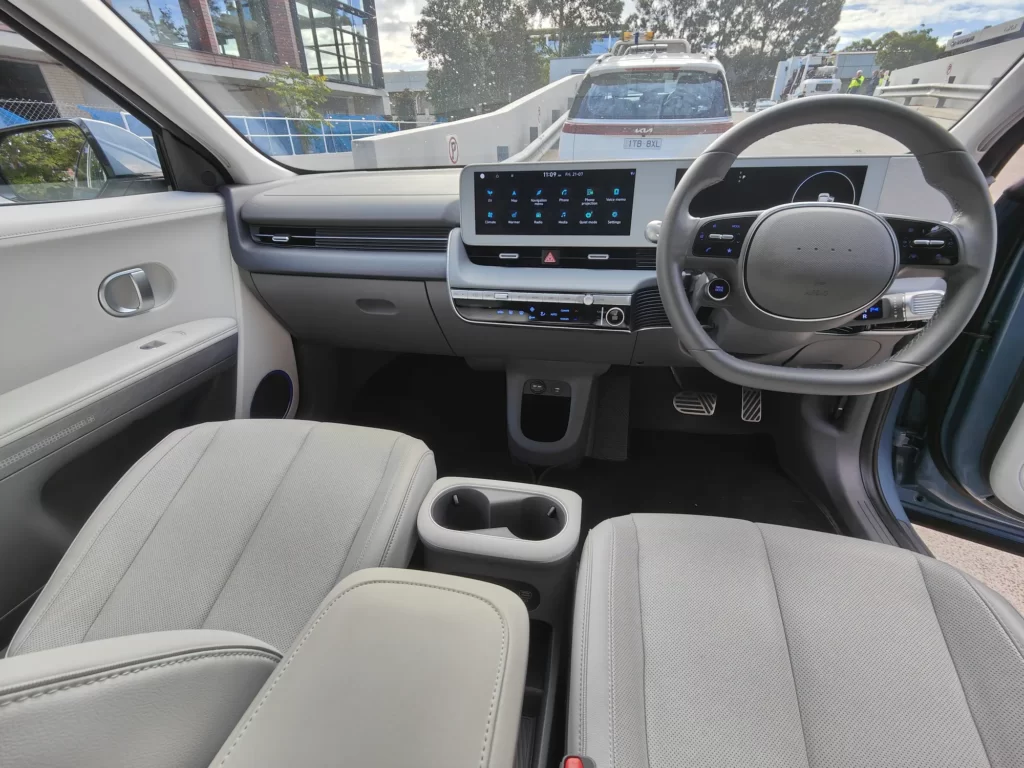I recently drove 372.6km in a Australian Hyundai Ioniq 5 Dynamiq 2023 electric car around Sydney, from short 10km return shopping trips to a long 287km drive from Sydney to Sutton Forest and back.
NOTE: a few days before publishing this article Hyundai revealed their Australian Ioniq 5 2024 range and new pricing.
All Australian Ioniq 5 versions now include a heat pump, battery heating system and battery conditioning as standard which means better efficiency, faster high end DC charging and better driving range especially in colder weather.
The Ioniq 5 2024 Dynamiq RWD has risen in price by $4000. So if you’ve already bought the 2023 version I tested and you don’t live in an area with cold winters that can benefit from a heat pump and battery heating, you scored a great deal.

Dynamiq refers to the base spec Ioniq 5 2023 version which is rear wheel drive and has a longer range than the more premium all wheel drive Ioniq 5 2023 Techniq and Ioniq 5 2023 Epiq.
While sold the Ioniq 5 2023 was available in these 3 versions (at driveaway pricing for NSW):
- Dynamiq – $74,558.00 (507km WLTP range)
- Techniq – $85,208.00 (454km WLTP range)
- Epiq – $90,964.00 (454km WLTP range)
Personally I like more range and RWD over things like a sunroof or more power. So compared to the two other versions I didn’t think the base Dynamiq model lacked anything I would actually want while driving.
Disclosure: The car was loaned by Hyundai Australia for 7 days to review. I agreed to meet all the associated running costs e.g. tolls, charging etc.

What I Liked
Exterior Design – This car turns heads. It attracted noticeably more attention from other drivers and pedestrians than any other EV I have reviewed.
The pixelated lighting design reminded me of 8 bit video games I played in the 80’s and early 90’s, while the external body is like what I would’ve imagined a retro futuristic car to look like when I was a kid.
Kudos for Hyundai for being bold and not releasing a bland EV design. Everyone won’t like it but I do.




Charging Speed – Hyundai promises 10% to 80% in 18 minutes on a 350kW charger. This is the same charging speed claim as other electric cars built on the Hyundai E-GMP platform eg: Kia EV6, Hyundai Ioniq 6, Genesis GV60.
I drove all the way to Evie Sutton Forest to see if this was achievable on a Sydney Winter day and was surprised to see that it was. Exactly after 18 minutes the car reached 80% charge after starting at 11%.
This charging speed capability won’t make any difference when using slower 50-150kW rate DC charging stations in the city but if you regularly need to use ultra fast DC chargers for work or drive long distances during family holidays then this feature will save you from wasting time.
Interior Design and Usability (mostly) – An example of how Hyundai has really thought about making driving easier is the blind spot camera view which appears on the screen in front of the driver when you signal turning left or right.
From the clever movable centre console which allows heaps of driver and front passenger legroom to the Heads Up Display projected onto the windshield and the big dual Driver Screens the interior design is in many ways excellent.
In comparison with other cars built on the E-GMP platform (KIA EV6 Air 490 litres, Hyundai Ioniq 6 401 litres, Genesis GV60 432 litres) the Ioniq 5 has the biggest boot



What Could Be Better
Some odd interior design decisions – While I mostly liked the interior design there are a few aspects which are annoying.
For a modern car at this price point it is inexplicable that it only has USB-A ports, luckily I keep a mixture of USB-A and USB-C cables in my car review stuff backpack otherwise I couldn’t have connected all my devices.
Secondly the Shifter stalk behind the right side of the steering wheel is a terrible location where at times I couldn’t see it easily because of the wheel position or my seating position.

Software (Where is the app and i-Pedal memory setting?) – Hyundai Bluelink is not included which is disappointing because at this price point people expect a fully featured app so they can control key car functions remotely eg: preheat/precool before they get to the car, monitor charging status, check the car is locked etc.
Also like all other Hyundai and Kia EV’s you have to turn i-Pedal (one pedal driving) on for the Ioniq 5 every single time you turn the car on. If you put the car into reverse i-Pedal also turns off for some reason and has to be manually turned on again.
It doesn’t have to be this way because the Polestar 2 always remembers your preferred regen braking setting.
Comfort and Handling – Not as good at top speed on motorways and poor quality roads compared to it’s cousin the Kia EV6 which was specifically tuned for Australian road conditions and feels more sporty and sure, especially on winding roads and twisty corners.
The Ioniq 5 Dynamiq is perhaps better for everyday city driving at 40-70 speeds and the Kia EV6 better for long trips.


Leave a Reply